For more than 75 years, the waters of Surigao Strait, Leyte Gulf, and the Philippine Sea have been the graveyard of countless naval vessels that fought gallantly during World War II.
Underneath the waves, hidden across the vast ocean bottom, are echoes of the past waiting to have their stories retold and once again claim their voice that had been silenced by its watery grave.
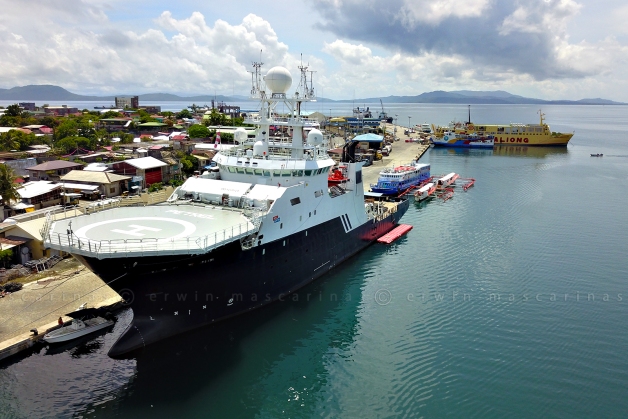
The world-renowned Research Vessel Petrel docked at Surigao City port and ferry terminal while undergoing minor maintenance.
Giving the shipwrecks voice and bringing their story out is a monumental task in which the Research Vessel Petrel hopes to accomplish.
Named after a seabird, the Petrel is a one of a kind research ship that specializes in locating WWII shipwrecks. Bought by Microsoft co-founder Philanthropist Paul Allen in 2016 for underwater research, the ship is known to be the only privately owned vessel in the world equipped to explore 19,685 ft or 6,000 meters depths.
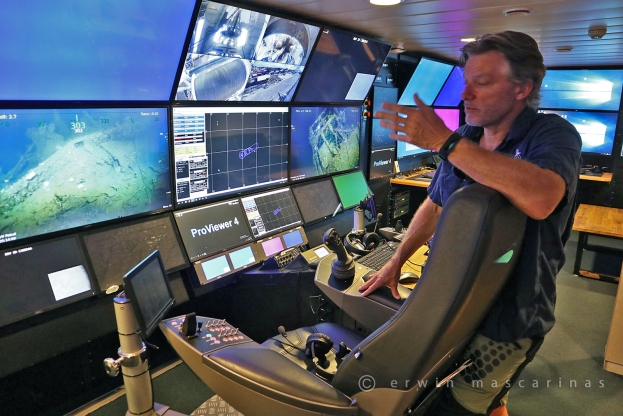
Robert Kraft, director of subsea operations for RV Petrel explains how the state-of-the-art control system for the Remote Operated Vehicle (ROV) and Autonomous Underwater Vehicle (AUV) works.
Allen had the ship refitted to go around the world in search of lost and undiscovered WWII wrecks. The mission is totally philanthropic and Allen’s estate namely, Vulcan Incorporated, pays for all the costs for the expedition.
Petrel works with national governments, museums and historical groups in the conduct of such explorations.
This year, RV Petrel returned to the port of Surigao City and hopes to stay longer with the goal of locating ships that once cruised with pride along the high seas.
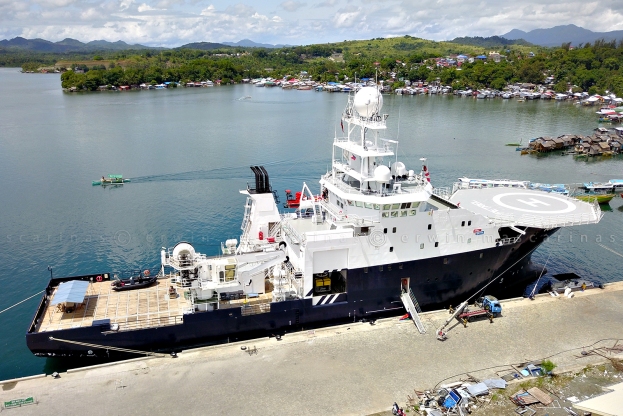
“The Philippines is rich with maritime archeological history, so we’ve done a lot of projects here with the National Museum and we plan to do more in the future. Surigao is in a great position in the Philippine archipelago and is very convenient as a major transit point,” said Robert Kraft, director of subsea operations for Vulcan Inc. and RV Petrel.
Kraft emphasized that locating WWII shipwrecks is also important to the veterans and families of those who once served aboard these ships.
“To those who lived it, it is a memory that has haunted their entire lives, of friends lost and tales of survival. For the families of those who perished with the ships, it is a bitter closure to a painful past. Our journey is beyond just the essence of discovery but to give a voice to the gallant last stand of those lost in the depths of a once-troubled past,” said Kraft.
Kraft who has been in the forefront of the research vessels operation explained that the Philippines has been a very integral part in the Petrel’s journey of discovery as the archipelago has given the team several discoveries to date.
Respecting the graveyards
Kraft emphasized that they abide by the policy of not touching or removing anything from the sunken ships unless requested to do so by their government. “We should consider these areas as the final resting places of the gallant sailors that manned these vessels,” said Kraft.
Kraft explained an instance that the team had to recover a bell from the British warship MHS Hood during an expedition on August 2015. Hood was sunk by the German battleship Bismark in the Atlantic on May 24, 1941.
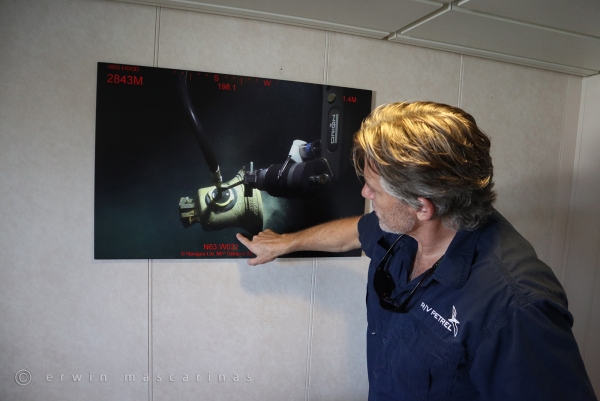
Kraft points at the photo made during the recovery of the bell from the British warship MHS Hood that was sunk by the German battleship Bismark in the Atlantic on May 24, 1941.
“In one occasion, we had to reconsider our policy, but only after being requested by official parties and obtaining a license from the UK Ministry of Defense,” said Kraft.
As a war grave, the wreck is protected, but recovery of the bell was performed upon the request of the HMS Hood Association and after receiving permission from the British government and the Admiralty.
Largest ship-to-ship Battle in History
On August 2017, right after RV Petrel’s discovery of the United States Navy heavy cruiser USS Indianapolis in the Philippine Sea, the vessel sailed to Surigao City to take part in the commemoration of the 73rd year of the Battle of Surigao Strait, one of the four naval engagements that was a part of the Battle of Leyte Gulf.
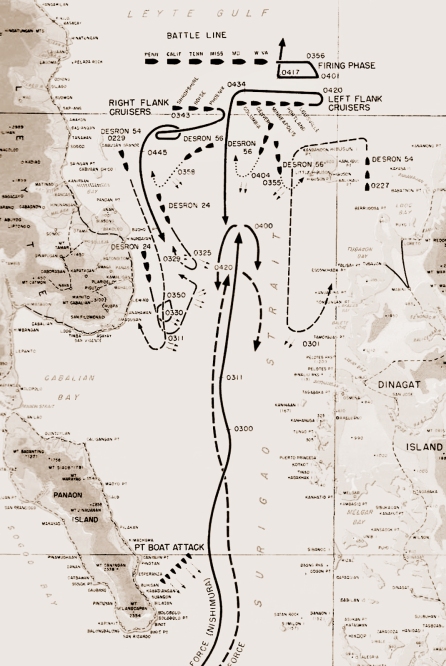
A map illustrating what was considered as the largest ship-to-ship battle in history
Petrel discovered almost an entire Japanese battle group on November 2017 after it surveyed Surigao Strait, giving the world a glimpse into the wrecks of the Japanese battleships Yamashiro, Fusō and the destroyers Michishio, Yamagumo and Asagumo.
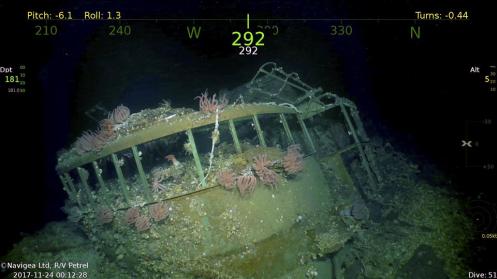
A photo that was taken by RV Petrel’s ROV, of the Asashio Class destroyer IJN Asagumo, found in Surigao Strait.
These Japanese imperial naval vessels were all sunk between October 24 to 25, 1944 by the American naval task group that comprised of six battleships, four heavy cruisers, four light cruisers, and 28 destroyers that blocked the Surigao Strait passage, protecting the massive landing operation in Leyte and Samar.
Together with a local historian, Petrel’s remote operated vehicle (ROV) investigated each of the sunken ships and confirmed the identities of the wreck.
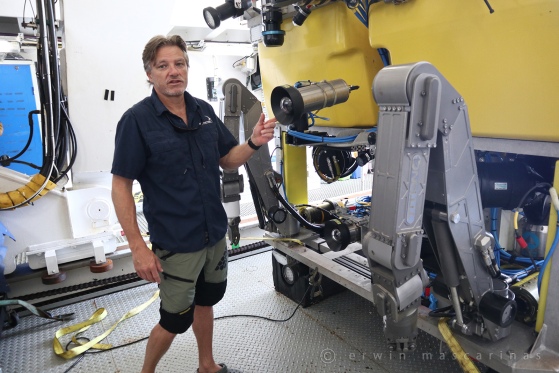
Kraft points at one of the two high definition cameras on the Remote Operated Vehicle (ROV) that is capable of submerging 6,000 meters depths.
Nearly 75 years after the greatest naval battle in history
Operation code name King II, was the landing of allied forces under General Douglas Macarthur in Leyte on October 20, 1944, paving the way for the liberation of the Philippines.
To protect the on-going landing of soldiers and logistics, the largest naval battle in history known as Battle of Leyte Gulf ensued form October 24 to 26, stretching into four main separate engagements; the Battle of the Sibuyan Sea, the Battle of Surigao Strait, the Battle of Cape Engaño and the Battle off Samar, with several smaller engagements from other surface vessels.
Local historian Jake Miranda, an underwater search consultant for missing aircraft and ships, and Petrel’s project coordinator for the Philippines explained the significance of the shipwrecks.
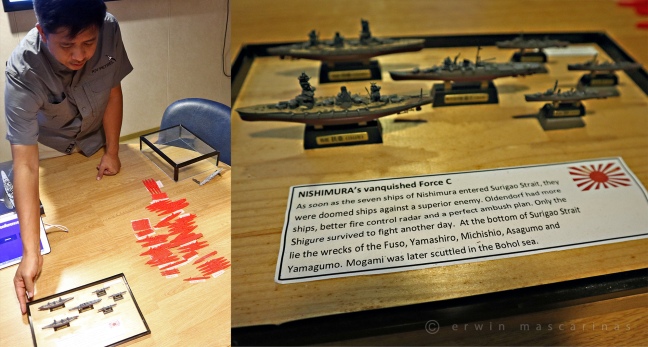
Local historian Jake Miranda, an underwater search consultant for missing aircraft and ships shows his own scaled model of the six Imperial Japanese Navy ships that sunk during the Battle of Surigao Strait.
“The Battle of Leyte Gulf, the main battle involved 294 surface combatants. The US and allied navies had 218 warships and gunboats while the Imperial Japanese Navy had 76 warships. These numbers do not include the thousands of troop carriers, merchant, marine, and landing crafts involved in the liberation of the Philippine islands,” said Miranda.
“Finding where these sunken ships are is like marking a site, and for families to know that we have found the last resting places of their loved ones. We also get the National Museum and other parties to officially declare these sites as war graves and accord them the needed protection from the law,” Miranda added.
Miranda noted that the Leyte Landing and the Battle of Leyte Gulf are considered as the Normandy D-day version of Asia and the Pacific.
“This October, we will commemorate the 75th year anniversary of the Battle of Surigao Strait in Surigao City and we are hoping for dignitaries and even several World War II veterans and their families to come and visit,” said Miranda.
To this day, the Battle of Surigao Strait is considered to be the last naval engagement that was exclusively fought between battleships and warships as well as part of the Battle of Leyte Gulf.
More Discoveries
By the end of 2017 towards early 2018, Petrel discovered the wrecks of USS Ward, USS Cooper, the Japanese destroyers Shimakaze, Wakatsuki, and Naganami in Ormoc Bay.
Between 2018 to 2019, Petrel’s voyage led to the discovery of the wrecks of three well-known aircraft carriers of the US Navy lost in WWII, the USS Lexington in the Coral Sea, USS Hornet in the Solomon Islands, and USS Wasp in Guadalcanal.
Seven other naval vessels including a battleship, heavy cruisers, destroyers, and a submarine were discovered in this timeline with the most recent discovery on February 2019 with the Japanese heavy cruiser Furutaka in the Guadalcanal area.
“We are not certain where our next voyage will take us, we will be staying here in Surigao City for the next few weeks to resupply and for some minor maintenance and repairs. For us, each discovery is as important as the other,” said Kraft.
“We don’t put labels as to what’s the best or the biggest as everyone is unique and everyone has a special story. What is important is how we bring the story of the heroism and gallantry of these men who perished and survived, and their humanity,” concluded Kraft.
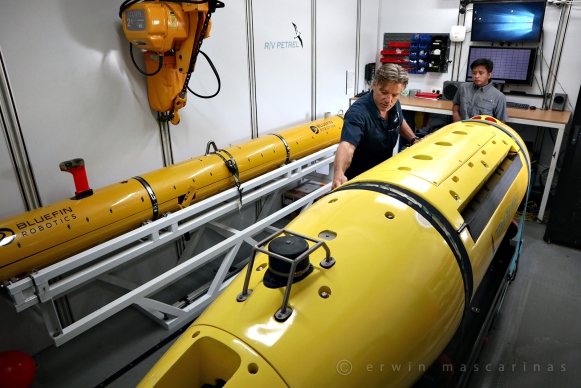
Robert Kraft together with local historian and underwater search consultant Jake Miranda checks the side sonar of the Remus 6000 Autonomous Underwater Vehicle (AUV) that can scan 1,000 m (3,281 ft) on each side, and can map from 100 to 150 square kilometers (39 to 58 sq mi) during each deployment. On the left, a Bluefin 12D AUV can also be seen on the photo.
I should have listened to my history teacher when I was in highschool in regards to battleships then I could relate more. I wonder what else would Kraft and Miranda would discover, sounds like Surigao’s rich in underwater artifacts. Great read here Erwin!
LikeLike